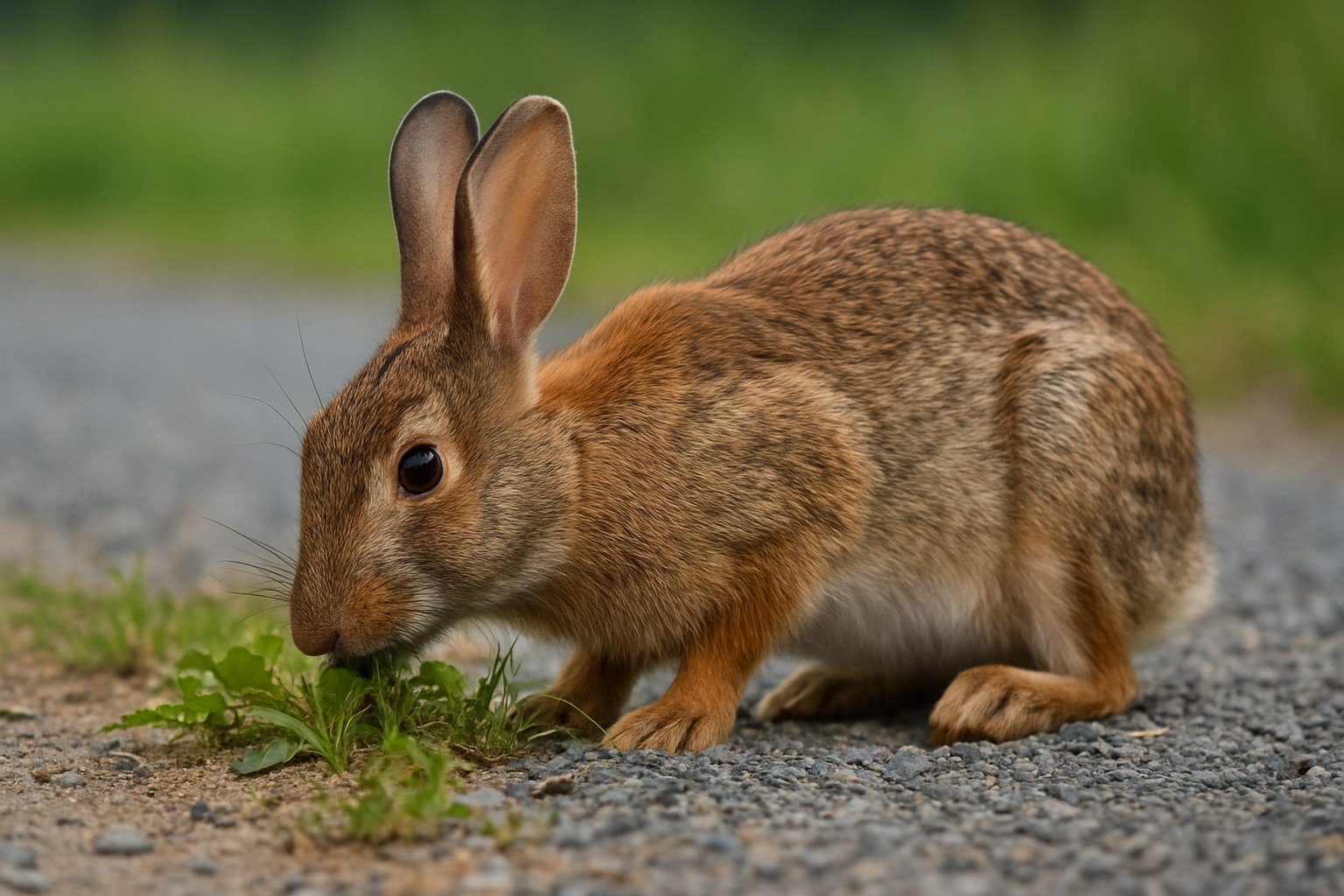Wild rabbits are often spotted near gravel roads, especially in rural and semi-wild areas. While it may seem unusual at first glance, these curious creatures are not wandering aimlessly. They’re foraging. This article dives deep into what rabbits eat from gravel roads, exploring the specific types of food and minerals they seek out in these seemingly barren environments.
Understanding their feeding habits not only offers insights into rabbit ecology but also highlights the subtle interactions between wildlife and human-altered landscapes.
In This Article
Why Are Rabbits Found on Gravel Roads?
Rabbits are prey animals, naturally cautious and always on the lookout for food, shelter, and safety. So why do they risk venturing onto gravel roads?
Here are a few reasons:
- Access to Food: Roadsides are often lined with vegetation not found deeper in the woods or fields. Gravel roads, being less trafficked than paved highways, allow these plants to flourish.
- Warm Surfaces: In colder climates, gravel roads retain heat from the sun. Rabbits may rest or forage in these areas to warm up, especially during spring or autumn.
- Mineral Hunting: Gravel roads may contain salts, calcium, and other minerals rabbits instinctively seek out.
- Low Traffic Disturbance: Unlike paved roads, gravel paths typically see less vehicular activity, making them safer for wildlife.
“Wild rabbits have adapted well to human-altered environments, often turning the edges of roads into convenient foraging grounds.” — Dr. Rachel Ferber, Wildlife Ecologist
Types of Vegetation Growing Near Gravel Roads
One of the main attractions for rabbits around gravel roads is the abundant roadside vegetation. These areas are disturbed habitats—often cleared, scraped, and unmanaged—which allows resilient plant species to thrive. These “weeds” are often nutrient-rich and highly palatable to herbivores like rabbits.
Common Edible Plants Rabbits Consume Along Gravel Roads:
| Plant Name | Description | Edibility for Rabbits |
| Dandelion | Broad leaves, yellow flowers, grows prolifically | High in fiber and nutrients |
| Clover (White/Red) | Found in sunny patches, nitrogen fixer | Rich in protein and calcium |
| Plantain Weed | Low-lying, oval leaves, common in compacted soil | Natural digestive aid |
| Chickweed | Cool-season plant with small white flowers | Gentle on rabbit stomachs |
| Foxtail Grass | Tall seedheads, grows in gravel-rich soil | Seeds can be eaten cautiously |
| Wild Grasses | Various roadside species | Core part of rabbit diet |
Additional Notes:
- These plants are often more accessible near gravel roads than in dense fields or forests.
- Road maintenance (like mowing or scraping) can stimulate new plant growth, which rabbits prefer due to tenderness.
“The edges of gravel roads act like natural salad bars for wild rabbits.” — Tom Jenkins, Field Naturalist
Important: The vegetation varies by region and season. Spring and early summer offer the richest roadside buffet, while late fall sees a decline in fresh greens.
Gravel Roads as a Source of Minerals for Rabbits
Gravel roads may seem nutritionally barren, but they can actually provide essential trace minerals that wild rabbits crave. These animals have evolved to find resources in their environment, and gravel roads often contain materials that fulfill these biological needs.
Why Rabbits Might Eat Gravel or Soil:
- Calcium and Phosphorus: These are vital for bone and teeth health.
- Salt Residue: Especially in areas where roads are salted during winter, rabbits may return to lick salt deposits off the gravel.
- Natural Grit: Helps in grinding down plant material in the digestive system, especially for wild rabbits with no access to artificial supplements.
“It’s not unusual to see small herbivores like rabbits ingesting bits of soil or gravel — this behavior is known as geophagy.” — Dr. Linda Zhou, Wildlife Nutrition Specialist
However, this behavior can be risky. Contaminants like petroleum, herbicides, or deicing chemicals might also be present, leading to potential toxicity.
Roadside Grass and Herbaceous Plants Rabbits Eat
The areas flanking gravel roads often support a unique combination of grass species and herbaceous plants that rabbits find both palatable and beneficial.
Highly Favored Grasses & Plants:
- Timothy Grass: Provides roughage and is often part of domestic rabbit diets.
- Orchard Grass: Soft-bladed and rich in fiber.
- Sweet Vernal Grass: Aromatic, often found along disturbed roadsides.
- Yarrow: Medicinal properties for animals; eaten in small amounts.
- Wild Lettuce: Mild sedative effects; consumed in moderation by rabbits.
These plants provide:
- Roughage for digestive health.
- Micronutrients including Vitamin A, Vitamin C, and iron.
- Moisture content, especially in dewy mornings.
Seasonality matters: Spring and early summer offer tender shoots, while fall growths are more fibrous and less preferred.
Consumption of Salt Residue
Salt might not seem like a typical item in a rabbit’s menu, but under certain environmental conditions, it becomes an important dietary supplement.
How and Why Rabbits Seek Salt from Roads:
- Winter Road Treatment: In cold climates, salt (sodium chloride or brine) is applied to roads to melt ice. These residues linger well into spring.
- Salt Licking Behavior: Rabbits, like deer, are observed licking or nibbling at salt-enriched gravel.
- Instinctual Need: Sodium is crucial for nerve function, hydration, and muscular coordination.
Warning: Excessive salt can be toxic to rabbits. Their bodies are not designed to handle large amounts of sodium. When possible, they regulate this intake instinctively, but the risk increases when residues are concentrated.
Interesting Fact: A 2022 field observation in Minnesota noted that rabbits returned repeatedly to a treated gravel lane after winter, avoiding untreated paths entirely.
Opportunistic Feeding: Insects and Other Organic Material
Although rabbits are obligate herbivores, meaning their digestive systems are designed for plant-based diets, some unusual foraging behaviors have been observed.
What Might They Accidentally Ingest?
- Dead insects on gravel, especially after rainfall.
- Birdseed or spilled livestock feed along rural roads.
- Small decomposing organic matter that may carry nutrients.
While this behavior isn’t typical or essential, it can happen accidentally while foraging for mineral-rich soil or plant material. It’s not out of necessity but a byproduct of where and how they eat.
“We once found traces of ant shells in a rabbit scat sample collected from a gravel road embankment. It was a surprising but explainable discovery.” — Field report, 2021 Alberta Wildlife Study
Human Food Waste and Litter: A Hidden Danger
Where people go, trash follows—and even in remote gravel roads, rabbits may encounter human food scraps.
Common Discarded Items Rabbits Might Nibble:
- Apple cores
- Chips or crackers
- Sandwich crusts
- Cereal or granola bits
- Fast food wrappers with residues
While these may seem “edible,” they’re harmful to rabbits:
- High salt, sugar, and fat contents disturb their digestion.
- Processed foods lead to gut imbalance or poisoning.
- Sharp packaging (e.g., chip bags) can trap or injure them.
Table: Risks of Human Food Waste for Rabbits
| Item | Rabbit Impact |
| Potato chips | High sodium, gastrointestinal upset |
| Fruit peels with pesticides | Toxin ingestion, liver stress |
| Moldy bread | Mycotoxin poisoning |
| Plastic packaging | Choking or intestinal blockage |
Wildlife authorities often advise: “Pack it in, pack it out.”
Gravel Roads vs. Paved Roads: Feeding Behavior Differences
Gravel roads offer a more rabbit-friendly environment compared to paved roads. Here’s why:
Advantages of Gravel Roads for Rabbit Foraging:
- More Vegetation: Grassy shoulders, wildflowers, and weeds grow freely.
- Less Traffic: Lower chance of being startled or run over.
- Natural Soil Exposure: Easier for rabbits to access minerals and dig small burrows.
- Salt Residue Retention: Gravel holds onto minerals longer than asphalt.
Comparison Table: Rabbit Behavior on Road Types
| Feature | Gravel Roads | Paved Roads |
| Vegetation Access | High | Low |
| Salt Residue Presence | Moderate–High | High (short-term) |
| Traffic Volume | Low | High |
| Foraging Safety | Better | Worse |
| Soil Accessibility | Excellent | Poor |
Dangers of Foraging on Gravel Roads
Despite the benefits, foraging along roads brings significant dangers to rabbits.
Key Risks:
- Predation: Open roads make rabbits visible to hawks, foxes, and coyotes.
- Vehicle Strikes: Even occasional traffic is a lethal threat.
- Chemical Exposure: Herbicides, fuel runoff, and de-icing chemicals are common.
- Parasites and Disease: Increased interaction with scavengers and waste areas.
Case Study: Ontario Wildlife Monitoring Project (2023)
- Found that 27% of rabbit fatalities within 5km zones of gravel roads were due to vehicle collisions.
- Many surviving individuals showed signs of digestive inflammation, likely due to contaminated roadside grazing.
Ecological Implications of Roadside Foraging
The fact that rabbits rely on roadside environments shows how human infrastructure shapes animal behavior.
Consequences:
- Changes in Diet: Increased reliance on non-native or disturbed plants.
- Adaptation Patterns: Rabbits foraging closer to humans become bolder but also more vulnerable.
- Impact on Ecosystems: Altered rabbit movement affects predator patterns, plant dispersal, and soil turnover.
This interaction also raises questions for land managers: Can road edges be managed in ways that support healthy wildlife behaviors?
Conclusion: What Do Rabbits Eat from Gravel Roads?
Gravel roads may look barren to the untrained eye, but for rabbits, they offer a surprising variety of food sources:
- Tender weeds and grasses
- Mineral-rich soil and salt
- Occasional human scraps (with serious risks)
- Unusual nutrients like grit and calcium from gravel
Yet, this buffet comes at a cost—predators, pollution, and traffic make gravel roads both a resource and a risk. Understanding this unique feeding behavior highlights just how adaptable—and vulnerable—rabbits are in shared human landscapes.
“If we want to preserve wildlife, we must first understand the small choices they make every day—like where to eat.”
FAQs: What Do Rabbits Eat from Gravel Roads?
Why do rabbits eat near gravel roads?
Rabbits are attracted to gravel roads because of the abundant roadside vegetation, access to minerals like salt and calcium, and lower traffic volume compared to paved roads. These roads often support edible plants and provide warm surfaces in cooler months.
Is it normal for rabbits to eat gravel or soil?
Yes, in small amounts. This behavior, called geophagy, allows rabbits to ingest trace minerals like calcium and phosphorus. They may also consume grit to aid in digestion. However, frequent consumption may expose them to toxins or road contaminants.
Do rabbits eat salt from roads?
They can. In winter or early spring, roads treated with salt or brine may leave residues that rabbits lick. This is usually driven by a biological need for sodium, though too much salt can be dangerous to their health.
What kinds of plants do rabbits eat along gravel roads?
Rabbits often eat:
- Dandelions
- Clover
- Plantain
- Wild grasses
- Yarrow
- Chickweed
These grow commonly along disturbed soils near gravel roads and are high in fiber and nutrients.
Can eating from gravel roads harm rabbits?
Yes. While some benefits exist, rabbits also face dangers:
- Vehicle collisions
- Chemical exposure (e.g., de-icers, herbicides)
- Human litter ingestion
- Predator vulnerability
Roadside foraging is a high-risk, high-reward behavior.
Do rabbits eat human food waste found on roads?
Sometimes. Rabbits may nibble on discarded fruit peels, bread, or snacks, but these are unnatural and potentially harmful. Processed food can disrupt their digestive systems and lead to serious health issues.
Are gravel roads better for rabbits than paved roads?
Generally, yes. Gravel roads offer more vegetation, less traffic, and more natural soil for rabbits to forage in. However, they still present risks and are not ideal compared to natural habitats.
Should we feed wild rabbits near gravel roads?
No. Feeding wild rabbits discourages natural foraging and increases the risk of road deaths and disease. It also disrupts local ecosystems and can attract predators to roadside areas.

